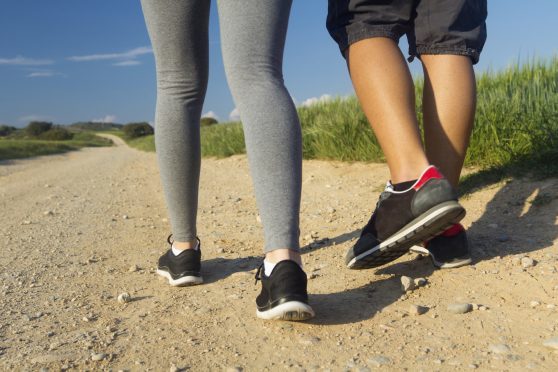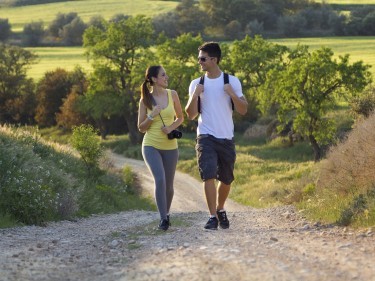Want to slim down and get healthier? Forget trendy workouts and pricey gym memberships – according to research, you’re better off going for a walk
If you’re dreading hitting the gym to shed those excess pounds, you may want to swap your gym membership for some good walking shoes.
New research from the London School of Economics and Political Science (LSE) found that people over 50, and women of all ages, who regularly walked briskly for more than 30 minutes at a time, had a lower body mass index (BMI) and smaller waists than those who say they favour other forms of exercise, including gym workouts, cycling and swimming. (Men aged under 50 had similar waist sizes whether they walked or went to the gym.)
WONDER WALKS
So what is it about walking that’s so effective? A very big factor is that people who like to walk tend to do it very regularly, so they are more active overall – compared with non-walkers who, while they may say they do other forms of exercise, are possibly doing them far less frequently.
Previous studies have also found that walking can be far more effective – in terms of aiding fitness and weight loss, and warding off diseases – than people might think. And, as Dr Grace Lordan, who led the LSE research, notes, people who take up walking tend to stick with it more than other fitness regimes.
“People are also more likely to get walking ’right’, as compared to gym exercises – it’s easier to know if you’re working to a moderate level with walking than with other exercises,” Dr Lordan adds.
She stresses that, although any exercise is better than none, to achieve significant results, walking needs to be at a decent pace, to a level where you’re perspiring and out of breath, for 30 minutes, five times a week.
ENDLESS BENEFITS
As well as helping with weight management, by taking up regular brisk walks, Dr Lordan points out: “Provided you don’t eat any worse, you could lower your cholesterol, blood pressure and risk of cardiovascular ill health, as well as improving your mental and physical health.
“Given that regular walking is an easier habit to adopt regularly than high-impact classes or complicated exercise regimes, I would have to say that we do underestimate how a regular walking habit could modify the lifestyles of many people.
“And walking costs nothing but your time.”
Although Government guidelines recommend that adults should be doing 150 minutes or more of moderate-intensity physical activity every week, there’s no guidance on which activity is the most effective – and it’s estimated that as many as 80% of the UK population aren’t meeting the recommendations anyway.
It’s because of this, as well as the multiple and accessible benefits of walking, that Dr Lordan is now calling for a campaign to promote it as an effective way to tackle obesity, rather than public health messages about healthy eating.
“I would like to see a walking campaign targeted at people who currently do no activity,” she says. “It would be fantastic to see a campaign that lets people know that every brisk step counts.”
Claire Francis, campaigns manager at the walking and cycling charity Sustrans, agrees, and points out: “Walking is the perfect exercise – free, simple, and easily incorporated into our daily routine and travels. But sadly, many of us are missing out.
“If taking regular walks were a drug, doctors would prescribe it to absolutely everyone. It’s a silver bullet for so many of our health, economic and environmental woes.”
WALKING WORKS
A recent report from The Ramblers and Macmillan Cancer Support – who run guided Walking For Health schemes in various locations across the UK (www.ramblers.org.uk/go-walking/get-healthy/walking-for-health.aspx) – suggested that 37,000 deaths could be prevented every year, if more of us started taking regular walks.
It pointed out that being active significantly reduces the risk of getting heart disease, stroke, Type 2 diabetes, breast and colon cancers and Alzheimer’s disease by 20-50%, as well as helping maintain a healthy weight, increasing good cholesterol, reducing blood pressure, building healthy muscles and bones, improving balance and reducing the risk of falls.
Furthermore, being physically active helps people feel less stressed, sleep better, have a 30% lower risk of getting depressed, and a reduced risk of developing dementia.
BEST FOOT FORWARD
Inspired to get our for a walk? Follow these NHS tips for getting started:
:: Start walking slowly, particularly if you’re not used to exercising, and build up to the recommended 30 minutes a day, five times a week.
:: Breaking walks up into three 10-minute chunks a day should achieve the same results, as long as you’re walking at a moderate pace.
:: To achieve the recommended moderate intensity aerobic activity, you need to walk fast enough to raise your heart rate and sweat.
:: Walk fast enough to be able to talk, but not sing.
:: Try to walk 10,000 steps a day. Most people normally walk between 3,000 and 4,000 steps a day.
:: Towards the end of the walk, gradually slow down your pace to cool down, and finish with a few gentle stretches, which will improve your flexibility.
:: Make walking a habit by building it into your routine, such as walking to the shops or work.

